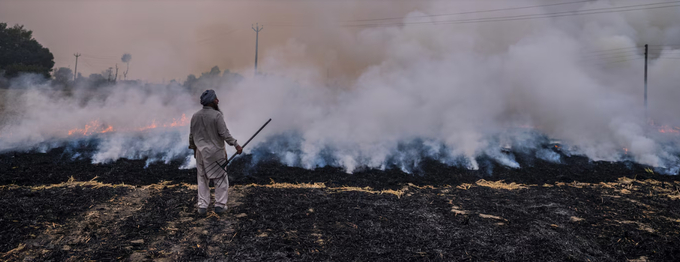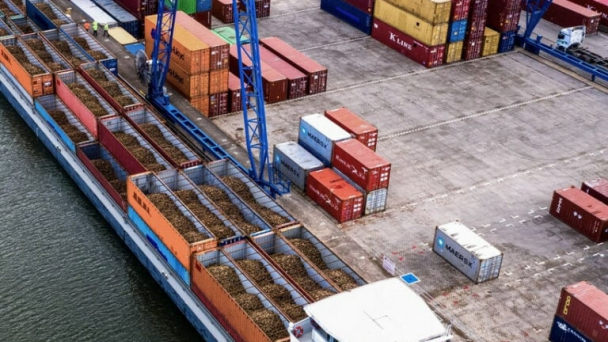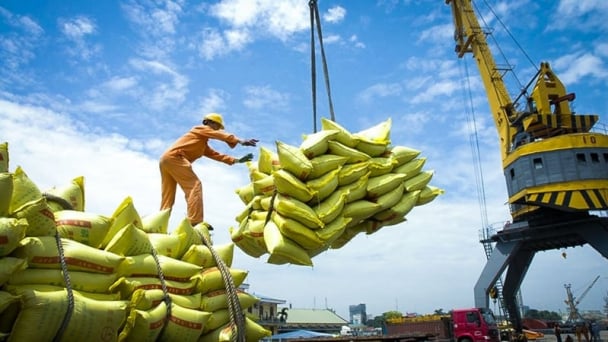May 30, 2025 | 08:40 GMT +7
May 30, 2025 | 08:40 GMT +7
Hotline: 0913.378.918
May 30, 2025 | 08:40 GMT +7
Hotline: 0913.378.918

A farmworker monitors the burning of rice crop stubble in the Patiala district of Punjab, India, in November 2019. Each year, India's rice farmers burn the stubble of the harvested crop, contributing to an annual haze.
An Indian initiative to preserve vanishing groundwater by delaying the annual sowing of rice has led to a dramatic worsening of air pollution in New Delhi and the surrounding region, already infamous for its suffocating smog, according to farmers and researchers. And no one saw it coming.
For decades, farmers have burned the field stubble that remains after harvesting rice to prepare for the next crop.
But when government officials ordered a delay in the summer sowing of rice by a few weeks in part of India to take advantage of the coming monsoon rain, they did not consider that winds would have shifted by harvest time. Now, the harvest coincides with winter weather, and the winds blow the smoke across the plains of northern India.
The agricultural mandate, first adopted in 2008, has caused up to a 20 percent increase in smoke particles in northern Indian cities, including Delhi, according to a team of researchers from the United States, India and elsewhere.
This week, Delhi’s poisonous air reached its worst level in five years. In response, the government shut down schools, construction and some offices.
“The growing season for rice has shifted, and you would think that would be fine,” said Loretta Mickley, an atmospheric chemist at Harvard University. “The average person will say: What does groundwater have to do with air pollution in Delhi?”
Gurpreet Sangha’s family owns farmland in two Indian states. In the western state of Rajasthan, where the government-ordered delay does not apply, his farmers continue to harvest rice and burn the stubble near the end of September.
Nearly a month later, after the winds have shifted, the farmers on the tract in the northern state of Punjab do the same. The law in Punjab prohibits sowing rice seedlings into nurseries of long troughs before mid-May and transplanting those seedlings into flooded paddies before mid-June, delaying the harvest and the stubble burning.
“If you are standing in my land in Rajasthan or in my family’s land in Punjab, the smoke from the burning is all the same,” Sangha said. “But in September, the smoke just withers away from Rajasthan. And in October or November, my smoke from Punjab goes and chokes Delhi.”
“They plugged one problem and gave rise to another,” he added.
The northern states of Punjab and Haryana have been known as India’s breadbasket, growing alternating crops of rice and wheat. But the irrigation of rice is water intensive, and the rapid depletion of groundwater in those states was putting the country’s food supply at risk.
So in 2008, the state governments mandated the delay of sowing until the start of the monsoon season, pushing back the harvest and burning of stubble.
Before the change, the winds at harvest time were “active, turbulent, with more ventilation,” Mickley said, demonstrating on a video call by moving her hands back and forth. “Later, the polluted air hugs the Earth.” She stacked her arms one above the other.
“We now have remarkable satellite images of huge swaths of smoke just making their way slowly, slowly,” she said. Since 2018, she and her colleagues have published academic papers documenting these effects.
The delay in rice cultivation has also prompted even more field burning than before, according to interviews with farmers, household surveys and satellite data. That’s because farmers have less time to prepare the fields for their next crop, usually wheat, and need to clear the fields more urgently. Harvard researchers found that the shift in timing has coincided with 40 percent more burning in Punjab.
“We have to take a step back and consider the whole picture,” said Tina Liu, another researcher who was at Harvard when she quantified the delay’s impact on air pollution. “There is this trade-off between the economics of getting the agricultural season transition smoothly versus the impact on people’s health.”
Despite the evidence, the government officer who drafted the law denies any impact on air pollution.
“There is not even a single unintentional consequence from this law,” said Kahan Singh Pannu, Punjab’s former secretary of the agriculture department. He said the delay in sowing times has not delayed harvests because new rice varieties take less time to mature. If the winds are now carrying smoke over Delhi, it may be due to climate change, he said, not his law.
Raised in a farming family, Pannu said that by 2006, he had grown alarmed by the speed at which Punjab’s water table was descending. It took him a half hour to draft the law delaying the rice cultivation, he recalled, and the measure was steadily adopted over the following years.
“If this law hadn’t been made, there would be no [rice] paddy in north India by now, and our country could be importing food grains,” he said.
The government bans the burning of fields, but a household survey by the researchers conducted in 2016 and 2017 found that as many as 80 percent of Punjab’s farmers burned the residue of their rice crops.
Since 2019, the Indian Supreme Court has repeatedly issued orders trying to hold farmers and government officials accountable for the burning, but the practice persists, filling Delhi’s skies with carcinogens every winter.
Under a rising full moon, Punjabi farmers who work for Sangha’s cousin recently explained why they feel forced to burn the fields after harvesting basmati rice. For one, they said, using a machine to gather the rice stubble is too expensive and takes too long. They also said that nutrients from the burned stubble help nourish the subsequent wheat crop.
In a neighboring district, another farmer gathered stubble remaining from his harvest into rows. Then he took a matchbox from his pocket, struck a match and threw it onto the stubble. The fire moved down the rows, issuing dark smoke and leaving heaps of ash. He nudged the burning material forward with a pitchfork and covered his nose with a handkerchief, periodically pausing to rub his burning eyes.
“I don’t have any other option,” said the 26-year-old farmer, who spoke on the condition of anonymity because the activity is illegal. He pointed toward the dark cloud forming above. “If I start thinking about pollution, I will end up starving my family.”
Within 15 minutes, his 10 acres of land was covered in a thick layer of smoke. Dozens of other fires were visible along the horizon.
At its root, the issue goes deeper than a change in timing, according to Jyoti Pande Lavakare, a clean air advocate in Delhi who dates the problem to India’s adoption of “green revolution” agricultural practices 60 years ago. The adoption of new farming techniques, irrigation and fertilizer allowed Punjabi farmers to begin growing rice along with wheat in an area where other crops requiring less water had long been cultivated. But rice cultivation is increasingly unsustainable here, agriculture experts say.
Now, the delay in sowing may be taking a toll, not only on Delhi’s air but on the global climate.
Some scholars have shown how crop burning releases black carbon, a pollutant even more effective than carbon dioxide at absorbing light and warming the atmosphere. Some scientists, and even the Indian government, have found that black carbon, commonly known as soot, is falling onto the glaciers of the Himalayas, heating the surface and quickening the melting.
“Human beings are inventive, and we always want to fix things,” Mickley said. But, she added, “scientists and policymakers should be aware that unintended consequences can occur when we change something on a large scale, like the timing for crops for hundreds of thousands of farms.”
(Washingtonpost)

(VAN) The mutual export of agrifood products between the European Union (EU) and the United Kingdom (UK) must occur again without certification, border controls or other red tape. This was agreed at the UK-EU summit.
/2025/05/22/5121-2-173645_677.jpg)
(VAN) NBSAP Tracker identifies strengths and areas for improvement in the National Biodiversity Strategy, based on each region’s priorities and capacities.

(VAN) The draft amendment to the Circular on rice export trading stipulates a periodic reporting regime for rice exporting enterprises.

(VAN) Dong Thap farmers attained an average profit margin of 64% during the summer-autumn 2024 crop (first season), while An Giang and Kien Giang farmers followed with 56% and 54%, respectively.

(VAN) As a doctoral student doing research on renewable energy and electrification at Harvard University, the author shares his musings on electricity, nature, and countryside memories.

(VAN) The decree on Extended Producer Responsibility (EPR) ensures transparent management and disbursement of support funds, avoiding the creation of a “give-and-take” mechanism.

(VAN) Hue City rigorously enforces regulations regarding marine fishing and resource exploitation, with a particular emphasis on the monitoring of fishing vessels to prevent illegal, unreported, and unregulated (IUU) fishing.